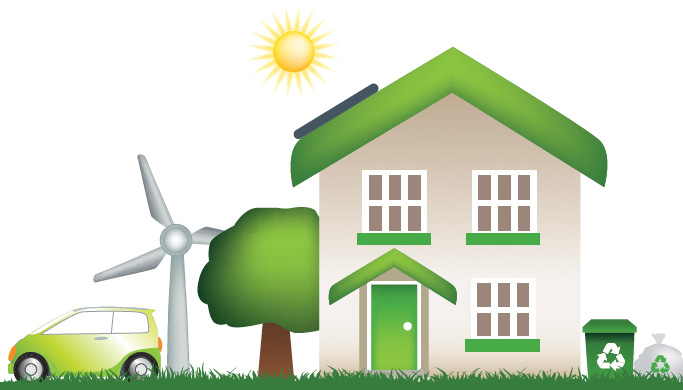These days, many home buyers are looking for eco-friendly features. Fortunately, greener options are being incorporated into more and more home designs, making it easier for homebuyers to find the house that's right for them.

The National Association of Realtors reports that in 2018, about 5.34 million existing homes were sold. Although building a new home is the most direct way of ensuring that your house is eco-friendly, you can find green features in pre-existing homes. Here are eight eco-friendly features to look for in your next home.
Find out if greener materials were used in the construction of the property you're interested in. Materials with a lower impact on the environment include salvaged or reclaimed wood and recycled items. You should also ask if materials used inside the home or in the home's structure are certified from sustainable sources, such as precast concrete, recycled steel, straw bales, and bamboo. Sustainable building materials will lower your energy usage and reduce your dependency on resources such as gas and oil that contribute to climate change.
Does the home you're looking at feature xeriscaping, a type of landscaping that uses drought-resistant plants and grass? If so, you'll use less water to maintain your yard. Is a sprinkler system installed? A sprinkler, too, is a way to use water efficiently. Does the lawn feature fake grass? This is actually a greener option because it doesn't need to be maintained with water-polluting chemicals and doesn't need water to stay green. Are the patio and walkways made of eco-friendly materials like mulch or wood chips? Of course, you can add these features if they don't already exist, but it's nice to have them in place before you even move in. A yard full of native plants can also support local wildlife.
You can spot Energy Star appliances in the store by searching for the blue logo with the star next to the word "energy." This logo indicates that the appliance has independent certification for energy efficiency without loss of functionality or popular features. Appliances and products that may be Energy Star certified include washers and dryers, dishwashers, freezers, refrigerators, ceiling fans, solar and/or tankless water heaters, skylights, windows, doors, and central air conditioning units. If tags with the logo have been removed, ask your real estate agent which appliances or products are Energy Star certified.
Water consumption is a serious global issue. Many nations are examining their water usage, especially those that have experienced a decrease in yearly rainfall in recent years. You can do your part by making sure your next home is using water efficiently. For instance, you can install water heaters that don't waste water. You will also cut down significantly on water waste if you use low-flow toilets, faucets, and showerheads. In the United States, there are about 27 million low-flush toilets in use, so this is a popular option for many families.
When looking at the existing appliances and fixtures in a home you're considering buying, look for the WaterSense label. The Environmental Protection Agency (EPA) states that WaterSense-labeled products undergo independent testing and certification, and meet EPA's specifications for efficient water usage. The WaterSense label can be found on toilets, showerheads, faucets, and lawn irrigation systems.
If you want a more sustainable water source, you may contact a well drilling company to drill and set up a water well in your property.
Solar panels are growing in popularity. It's usually easy to see that a home has solar panels. They can make any size house more eco-friendly. It's best to choose a home with panels already installed, which should be less expensive and less disruptive than buying and installing them yourself. You'll still want to ask your real estate agent when the panels were installed, how they operate, and the amount of energy they generate annually, which will indicate cost savings and the eco-friendliness of the home.
You can reduce energy waste by purchasing a home with dual-pane or Low-E windows. A dual-pane window has two panes of glass that keep a layer of air between them. The air layer provides insulation, holding heat in and keeping cold air out. This makes the windows more energy efficient. Similarly, Low-E or low-emittance windows insulate more effectively than standard windows and are therefore more energy efficient. Low-e window glass also shields the home's occupants from harmful UV rays.
The lighting available to homeowners is becoming increasingly energy-efficient. The typical annual electricity usage for an American residential utility customer in 2018 was 10,972 kilowatt-hours (kWh), or approximately 914 kWh used monthly. But you can make your electric lighting more efficient with advances such as the newer-model compact fluorescent bulbs. LED lights are even more energy-efficient and last longer. But the kind of bulb being used is not the only factor that will reduce your energy usage. Find out if the home you're interested in buying has motion sensors to shut off lights in unoccupied spaces. With motion sensors, you won't waste energy on an empty room, and kids won't need to remember to turn lights off every time they leave a room.
The kind of insulation you use in your home matters as some kinds offer greater energy efficiency. For instance, cellulose insulation, which is propelled into the cavity of the wall, is more energy-efficient than insulation sheets typically used in new construction homes. The cellulose can seal all the spaces in the wall and keep heat from being released, thereby saving on energy consumption. The type of insulation used for the roof should be similarly high in quality and keep heat from escaping. If you're interested in an older home, be aware that the insulation might be old and should be replaced.
If you're a home buyer looking for an eco-friendly house, you'll have to put in the effort required to find out if the property you're interested offers all the features you want. Ask questions about water and energy efficiency, landscaping, and sustainable building materials before you buy.